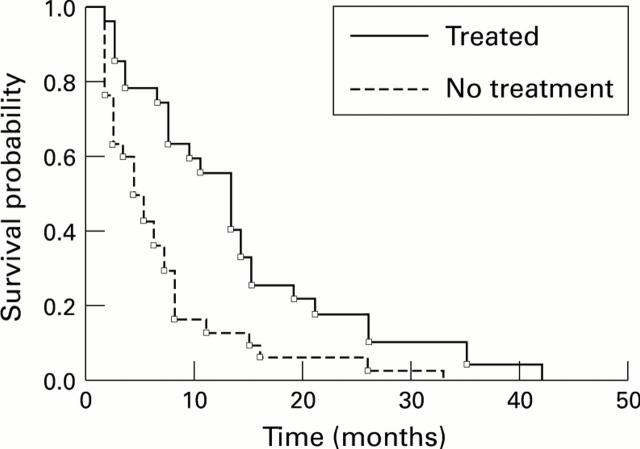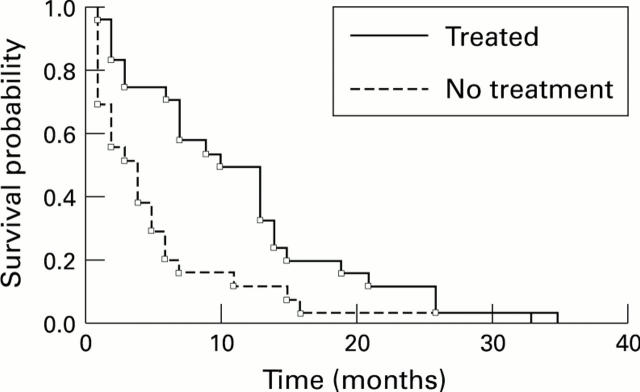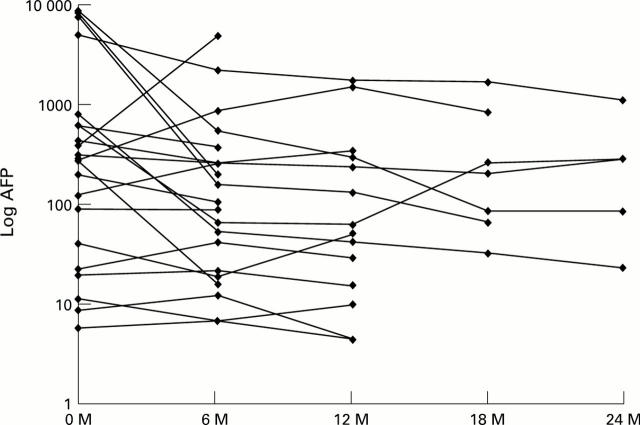Abstract
Background—Standard treatment of inoperable hepatocellular carcinoma has not been established. Somatostatin has been shown to possess antimitotic activity against a variety of non-endocrine tumours. Aims—To assess the presence of somatostatin receptors in human liver and to treat advanced hepatocellular carcinoma with the somatostatin analogue, octreotide. Methods—Somatostatin receptors were measured in liver tissue homogenates from patients with acute and chronic hepatitis, cirrhosis, and hepatocellular carcinoma. Fifty eight patients with advanced hepatocellular carcinoma were randomised to receive either subcutaneous octreotide 250 µg twice daily, or no treatment. Groups were comparable with respect to age, sex, Okuda classification, presence of cirrhosis, and liver biochemistry and virology. Results—Various amounts of somatostatin receptors were identified in liver tissue of all patients including those with hepatocellular carcinoma. Treated patients had an increased median survival (13 months versus four months, p=0.002, log rank test) and an increased cumulative survival rate at six and 12 months (75% versus 37%, and 56% versus 13% respectively). Octreotide administration significantly reduced α fetoprotein levels at six months. When a multivariable Cox's proportional hazards model was fitted, variables associated with increased survival were: treatment administration, absence of cirrhosis, increased serum albumin, and small tumours. Treated patients clearly had a lower hazard (0.383) in the multivariate analysis. Conclusions—Octreotide administration significantly improves survival and is a valuable alternative in the treatment of inoperable hepatocellular carcinoma.
Keywords: hepatocellular carcinoma; octreotide; somatostatin receptors; liver disease
Full Text
The Full Text of this article is available as a PDF (160.6 KB).
Figure 1 .
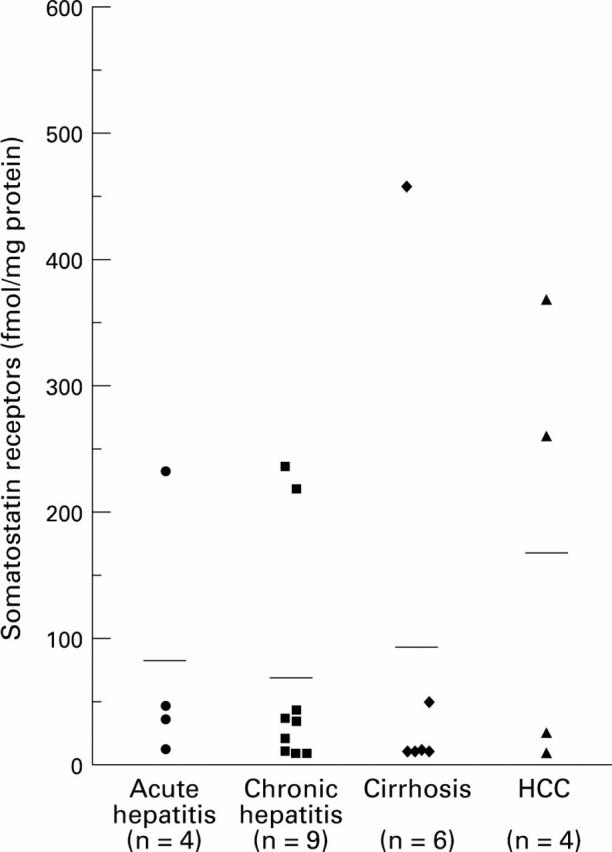
Somatostatin receptors in liver tissue. Patients with either low or high levels of receptors can be identified in all disease groups. HCC, hepatocellular carcinoma.
Figure 2 .
Survival curves for treated and non-treated patients with HCC.
Figure 3 .
Survival curves for treated and non-treated cirrhotics with HCC.
Figure 4 .
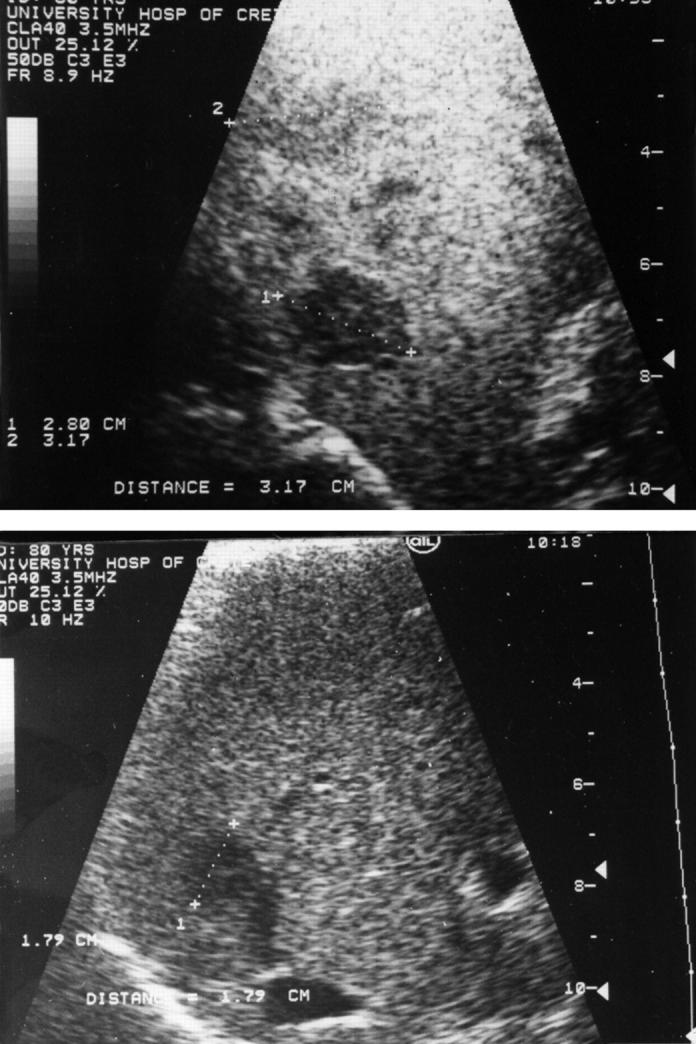
Liver ultrasound of a patient before (top panel) and after six months (bottom panel) of treatment with octreotide. Small satellite tumours have regressed while the large tumour remains unchanged.
Figure 5 .
AFP concentration in the treated group. M, months.
Selected References
These references are in PubMed. This may not be the complete list of references from this article.
- Bhattacharya S., Novell J. R., Dusheiko G. M., Hilson A. J., Dick R., Hobbs K. E. Epirubicin-Lipiodol chemotherapy versus 131iodine-Lipiodol radiotherapy in the treatment of unresectable hepatocellular carcinoma. Cancer. 1995 Dec 1;76(11):2202–2210. doi: 10.1002/1097-0142(19951201)76:11<2202::aid-cncr2820761105>3.0.co;2-8. [DOI] [PubMed] [Google Scholar]
- Bradford M. M. A rapid and sensitive method for the quantitation of microgram quantities of protein utilizing the principle of protein-dye binding. Anal Biochem. 1976 May 7;72:248–254. doi: 10.1006/abio.1976.9999. [DOI] [PubMed] [Google Scholar]
- Bronowicki J. P., Boudjema K., Chone L., Nisand G., Bazin C., Pflumio F., Uhl G., Wenger J. J., Jaeck D., Boissel P. Comparison of resection, liver transplantation and transcatheter oily chemoembolization in the treatment of hepatocellular carcinoma. J Hepatol. 1996 Mar;24(3):293–300. doi: 10.1016/s0168-8278(96)80007-9. [DOI] [PubMed] [Google Scholar]
- Bruno J. F., Xu Y., Song J., Berelowitz M. Tissue distribution of somatostatin receptor subtype messenger ribonucleic acid in the rat. Endocrinology. 1993 Dec;133(6):2561–2567. doi: 10.1210/endo.133.6.8243278. [DOI] [PubMed] [Google Scholar]
- Bruns C., Stolz B., Albert R., Marbach P., Pless J. OctreoScan 111 for imaging of a somatostatin receptor-positive islet cell tumor in rat. Horm Metab Res Suppl. 1993;27:5–11. [PubMed] [Google Scholar]
- Chao Y., Chan W. K., Huang Y. S., Teng H. C., Wang S. S., Lui W. Y., Whang-Peng J., Lee S. D. Phase II study of flutamide in the treatment of hepatocellular carcinoma. Cancer. 1996 Feb 15;77(4):635–639. [PubMed] [Google Scholar]
- Di Carlo V., Ferrari G., Castoldi R., Nadalin S., Marenghi C., Molteni B., Taccagni G., Castrucci M. Surgical treatment and prognostic variables of hepatocellular carcinoma in 122 cirrhotics. Hepatogastroenterology. 1995 Jul;42(3):222–229. [PubMed] [Google Scholar]
- Dörr U., Wurm K., Höring E., Guzman G., Räth U., Bihl H. Diagnostic reliability of somatostatin receptor scintigraphy during continuous treatment with different somatostatin analogs. Horm Metab Res Suppl. 1993;27:36–43. [PubMed] [Google Scholar]
- Ginès A., Salmerón J. M., Ginès P., Jiménez W., Saló J., Piera C., Clària J., Rivera F., Arroyo V., Rodés J. Effects of somatostatin on renal function in cirrhosis. Gastroenterology. 1992 Dec;103(6):1868–1874. doi: 10.1016/0016-5085(92)91446-b. [DOI] [PubMed] [Google Scholar]
- Greenman Y., Melmed S. Expression of three somatostatin receptor subtypes in pituitary adenomas: evidence for preferential SSTR5 expression in the mammosomatotroph lineage. J Clin Endocrinol Metab. 1994 Sep;79(3):724–729. doi: 10.1210/jcem.79.3.7521350. [DOI] [PubMed] [Google Scholar]
- Krenning E. P., Bakker W. H., Kooij P. P., Breeman W. A., Oei H. Y., de Jong M., Reubi J. C., Visser T. J., Bruns C., Kwekkeboom D. J. Somatostatin receptor scintigraphy with indium-111-DTPA-D-Phe-1-octreotide in man: metabolism, dosimetry and comparison with iodine-123-Tyr-3-octreotide. J Nucl Med. 1992 May;33(5):652–658. [PubMed] [Google Scholar]
- Kubota A., Yamada Y., Kagimoto S., Shimatsu A., Imamura M., Tsuda K., Imura H., Seino S., Seino Y. Identification of somatostatin receptor subtypes and an implication for the efficacy of somatostatin analogue SMS 201-995 in treatment of human endocrine tumors. J Clin Invest. 1994 Mar;93(3):1321–1325. doi: 10.1172/JCI117090. [DOI] [PMC free article] [PubMed] [Google Scholar]
- Lamberts S. W., Krenning E. P., Reubi J. C. The role of somatostatin and its analogs in the diagnosis and treatment of tumors. Endocr Rev. 1991 Nov;12(4):450–482. doi: 10.1210/edrv-12-4-450. [DOI] [PubMed] [Google Scholar]
- Lamberts S. W., van der Lely A. J., de Herder W. W., Hofland L. J. Octreotide. N Engl J Med. 1996 Jan 25;334(4):246–254. doi: 10.1056/NEJM199601253340408. [DOI] [PubMed] [Google Scholar]
- Liapakis G., Thermos K. Characterization of [125I]Tyr11-somatostatin binding sites in the rabbit retina. Neuropeptides. 1992 Jan;21(1):13–19. doi: 10.1016/0143-4179(92)90148-p. [DOI] [PubMed] [Google Scholar]
- Liebow C., Reilly C., Serrano M., Schally A. V. Somatostatin analogues inhibit growth of pancreatic cancer by stimulating tyrosine phosphatase. Proc Natl Acad Sci U S A. 1989 Mar;86(6):2003–2007. doi: 10.1073/pnas.86.6.2003. [DOI] [PMC free article] [PubMed] [Google Scholar]
- Madden M. V., Krige J. E., Bailey S., Beningfield S. J., Geddes C., Werner I. D., Terblanche J. Randomised trial of targeted chemotherapy with lipiodol and 5-epidoxorubicin compared with symptomatic treatment for hepatoma. Gut. 1993 Nov;34(11):1598–1600. doi: 10.1136/gut.34.11.1598. [DOI] [PMC free article] [PubMed] [Google Scholar]
- Manesis E. K., Giannoulis G., Zoumboulis P., Vafiadou I., Hadziyannis S. J. Treatment of hepatocellular carcinoma with combined suppression and inhibition of sex hormones: a randomized, controlled trial. Hepatology. 1995 Jun;21(6):1535–1542. [PubMed] [Google Scholar]
- Patel Y. C., Greenwood M. T., Warszynska A., Panetta R., Srikant C. B. All five cloned human somatostatin receptors (hSSTR1-5) are functionally coupled to adenylyl cyclase. Biochem Biophys Res Commun. 1994 Jan 28;198(2):605–612. doi: 10.1006/bbrc.1994.1088. [DOI] [PubMed] [Google Scholar]
- Patel Y. C., Srikant C. B. Subtype selectivity of peptide analogs for all five cloned human somatostatin receptors (hsstr 1-5). Endocrinology. 1994 Dec;135(6):2814–2817. doi: 10.1210/endo.135.6.7988476. [DOI] [PubMed] [Google Scholar]
- Pruthi R. S., Farouk M., Tsai W. H., Michalopoulos G., Meyers W. C. The effect of octreotide on hepatic regeneration in rats. Surgery. 1993 Jan;113(1):84–89. [PubMed] [Google Scholar]
- Ren S. G., Ezzat S., Melmed S., Braunstein G. D. Somatostatin analog induces insulin-like growth factor binding protein-1 (IGFBP-1) expression in human hepatoma cells. Endocrinology. 1992 Nov;131(5):2479–2481. doi: 10.1210/endo.131.5.1385103. [DOI] [PubMed] [Google Scholar]
- Reubi J. C., Kvols L., Krenning E., Lamberts S. W. Distribution of somatostatin receptors in normal and tumor tissue. Metabolism. 1990 Sep;39(9 Suppl 2):78–81. doi: 10.1016/0026-0495(90)90217-z. [DOI] [PubMed] [Google Scholar]
- Reubi J. C., Schaer J. C., Waser B., Mengod G. Expression and localization of somatostatin receptor SSTR1, SSTR2, and SSTR3 messenger RNAs in primary human tumors using in situ hybridization. Cancer Res. 1994 Jul 1;54(13):3455–3459. [PubMed] [Google Scholar]
- Schally A. V. Oncological applications of somatostatin analogues. Cancer Res. 1988 Dec 15;48(24 Pt 1):6977–6985. [PubMed] [Google Scholar]
- Schally A. V., Redding T. W. Somatostatin analogs as adjuncts to agonists of luteinizing hormone-releasing hormone in the treatment of experimental prostate cancer. Proc Natl Acad Sci U S A. 1987 Oct;84(20):7275–7279. doi: 10.1073/pnas.84.20.7275. [DOI] [PMC free article] [PubMed] [Google Scholar]
- Scudamore C. H., Ragaz J., Kluftinger A. M., Owen D. A. Hepatocellular carcinoma. A comparison of Oriental and Caucasian patients. Am J Surg. 1988 May;155(5):659–662. doi: 10.1016/s0002-9610(88)80138-7. [DOI] [PubMed] [Google Scholar]
- Takeda Y., Escribano M. J. Effects of insulin and somatostatin on the growth and the colony formation of two human pancreatic cancer cell lines. J Cancer Res Clin Oncol. 1991;117(5):416–420. doi: 10.1007/BF01612760. [DOI] [PubMed] [Google Scholar]
- Thermos K., Reisine T. Somatostatin receptor subtypes in the clonal anterior pituitary cell lines AtT-20 and GH3. Mol Pharmacol. 1988 Apr;33(4):370–377. [PubMed] [Google Scholar]
- Theveniau M. A., Yasuda K., Bell G. I., Reisine T. Immunological detection of isoforms of the somatostatin receptor subtype, SSTR2. J Neurochem. 1994 Aug;63(2):447–455. doi: 10.1046/j.1471-4159.1994.63020447.x. [DOI] [PubMed] [Google Scholar]
- Trichopoulos D., Tabor E., Gerety R. J., Xirouchaki E., Sparros L., Munoz N., Linsell C. A. Hepatitis B and primary hepatocellular carcinoma in a European population. Lancet. 1978 Dec 9;2(8102):1217–1219. doi: 10.1016/s0140-6736(78)92097-4. [DOI] [PubMed] [Google Scholar]
- van Eijck C. H., Slooter G. D., Hofland L. J., Kort W., Jeekel J., Lamberts S. W., Marquet R. L. Somatostatin receptor-dependent growth inhibition of liver metastases by octreotide. Br J Surg. 1994 Sep;81(9):1333–1337. doi: 10.1002/bjs.1800810925. [DOI] [PubMed] [Google Scholar]



